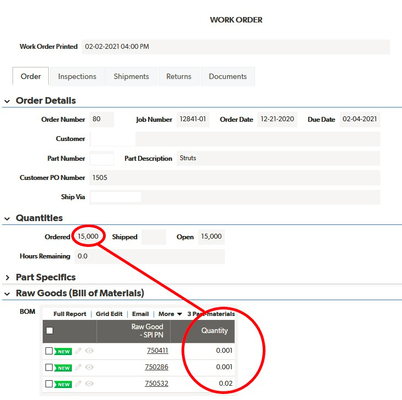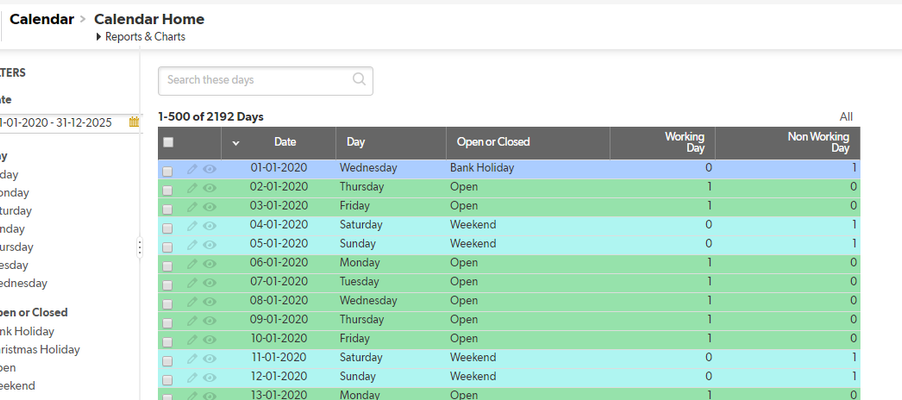Cross-Table Report Formulas
I am using QB in our manufacturing facility and am trying to get an order-by-order bill of materials. Specifically, I have a table for "Raw Goods" (the raw materials we make into parts), "Parts" (the things we sell), "Assigned Goods" (an intermediate table creating a many-to-many relationship between Raw Goods and Parts), and an "Orders" table (where individual orders for parts are entered). Each part record has a bill of materials that specifics how many pounds of of each raw good is needed to make one part. When I enter an order in the Orders table and enter the quantity of parts ordered, I need the Order record to multiply the quantity of each raw good by the number of parts ordered. I can figure out how to the get the original bill of materials to show up on the Order record (by looking up the embedded bill of materials report from the related Part record), but how do I then multiply the quantity of parts ordered in the Order record by the individual raw good quantities? In the example below, I would need a column multiplying each value by 15,000. Any suggestions are much appreciated! ------------------------------ Kiel Berry ------------------------------1.3KViews0likes2CommentsHow to use formula or summary field to get latest record data?
I have a table sales and a child table of products. I am trying to find the latest related child (products) field "price". I can create a summary field on the parent to get the latest date but it will not get me the "price" field. How do I use the formula field to get the latest date record and return the "price" value of that record? Thanks!418Views0likes9CommentsCalculate total working days between dates (including Bank holidays)
Hi I am aiming to calculate the total amount of working days between two dates whilst also considering Weekends, Bank holidays and Christmas Holiday etc. I have created a calendar for the next 5 years which puts a 1 next to the days that are actual working days. Within this table the desired result is achieved by simply filtering the start and end date and it totals up the working days, however I need this result to appear as a result of a start and end date on another table. Any help appreciated. After I have achieved this I will also need to calculate the end date based on a start date and adding a number of working days, which again needs to consider Weekends, Bank holidays and Christmas Holiday etc. Thank you in anticiption. ------------------------------ Stu ------------------------------315Views0likes9CommentsChanging the primary key field in a table that already has relationships
When I created my QuickBase application, I didn't have the full set of data (no primary keys). So I imported the data into QuickBase, allowing it to create it's own Primary Key. There are now 2 tables with relationships linked to those temporary Primary Keys. Today, I got the full set of data, including their internal primary keys (just a sequential number). So what I'd like to do is update the temporary key with with company's key. I tried using Quickbase's internal tool, but if I import the company's key and set that as the key in the Field section, it won't automatically set primary keys for new records. I tried overwriting the temporary keys values, but Quickbase makes them un-editable. I tried importing in new values for the temporary keys, but I get an error saying, "Cannot find all key numbers" or "Can't update two columns at the same time". There must be a way to do this? Or do I literally need to make a new table without data and re-create all my relationships manually? But even if I do that, will Quickbase automatically increment the assigned internal primary key, or will I have to update it? Thanks!312Views1like5CommentsDisplay field of most recent child record?
Parent table: Computers I want a field in this table to reflect the most recent "status" that was entered for each child record in a Statuses table. I'm sorry -- I'm sure this has been answered somewhere, but I've tried about five different searches to see where the answer for this question would be. Thank you!303Views0likes26CommentsCalculation/Performance Limits Inquiry
Hi all, I'll try to keep this as brief as possible. I'd like to know if anyone has a similar sized application in production and if they see any performance issues as it pertains to record loading and report loading. I have an Accounts table (table A) that will have 1,500 records total at any given time. This table has 3 children tables B, C, and D with 72,000; 168,000; and 168,000 total records at any given time, respectively. These children records will all have an Account# to tie it to their parent. On table A, I need to keep up to 4 years worth of data (Current Year, Prior Year, etc.). As a result, I will need about 1,500 to 1,750 currency summary fields per year (6,000 to 7,500 in total). This number then gets doubled because Quickbase does not have a built-in way to display numbers in Accounting format, so I need an additional 6,000 to 7,500 rich text formula fields. At no point in table A should I ever need a report with more than 12 columns of calculated summary fields for all 1,500 Account records. This is the max performance need. On the forms, I plan to "only" have 6,000 to 7,500 of the 12,000 to 15,000 total fields displayed. This will be broken across 4 different tabs (hoping that improves performance) for each year of data. Then each tab will be broken into 6 sections, which can be pre-minimized if it will help load times & performance (Actuals, Budget, Forecast, Actuals VS Budget, Actuals, VS Forecast, Budget VS Forecast). This table A is my biggest concern. If you care for additional context: In addition to this, table A will be a child to table E (Summary Report Rows). There will be 12/13 total Summary Reports (table F; parent to table E), made up of about 168 table E records. To restate, the 168 records will be parents via 3 relationships to the Accounts (table A). There is 1 relationship per key/vital column in the Accounts table. These will be running calculations based on the summary field calculations in table A. I'll leave it at this for the time being to see if anyone is able to take the time to respond. At the end of the day, I've never built something with this many calculations and I'm not entirely sure on the order of operations for Quickbase when it comes to forms. Regards, CurtisSolved299Views0likes10CommentsUsing Not IsNull
I am currently using the formula in my quickbase app. It shows this in a numeric version If(not IsNull([Rate Override]), [Rate Override],[Rate Snapchat]) In my question, I was wondering if there is a way to do this with text where it would useStatus 1 (Multiple Choice)Status 2 (Other a Text line)Status (Will choose from one or the other depending on the blank field) I was also wondering if I could get a list of things in other that people write so I can determine if it is valuable enough to add int other regular multiple choice options226Views0likes4Comments

